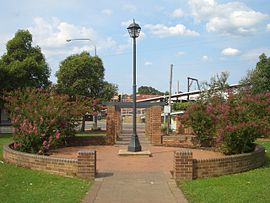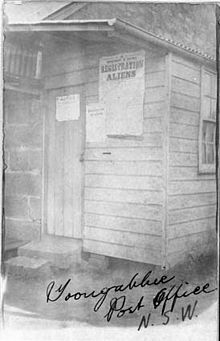Toongabbie: Difference between revisions
Crusoe8181 (talk | contribs) mNo edit summary |
|||
| Line 85: | Line 85: | ||
* [[Matthew Lyle Smith]] - Australian musical solo artist now based in Melbourne, lived in Toongabbie from birth in 1970 before leaving in 2000. |
* [[Matthew Lyle Smith]] - Australian musical solo artist now based in Melbourne, lived in Toongabbie from birth in 1970 before leaving in 2000. |
||
Councillor Scott Lloyd, Parramatta City Councillor has been a resident since 2005 |
|||
==End notes== |
==End notes== |
||
Revision as of 08:08, 26 March 2012
| Toongabbie Sydney, Error: unknown |state= value (help) | |||||||||||||||
|---|---|---|---|---|---|---|---|---|---|---|---|---|---|---|---|
 Portico Park | |||||||||||||||
| Population | 12,800 | ||||||||||||||
| • Density | 545.8/km2 (1,414/sq mi) | ||||||||||||||
| Established | 1792 | ||||||||||||||
| Postcode(s) | 2146 | ||||||||||||||
| Area | 23.453 km2 (9.1 sq mi) | ||||||||||||||
| Location |
| ||||||||||||||
| LGA(s) | Parramatta, Blacktown, Holroyd | ||||||||||||||
| State electorate(s) | Toongabbie | ||||||||||||||
| Federal division(s) | Greenway | ||||||||||||||
| |||||||||||||||
Toongabbie is a suburb of Sydney, in the state of New South Wales, Australia. Toongabbie is located 30 kilometres west of the Sydney central business district and is part of the Greater Western Sydney region. Toongabbie is split between the local government areas of the City of Parramatta, the City of Blacktown and the City of Holroyd. The suburb is often locally referred to as "Toonie" and "Toonga Bay".[1][2]
Geography
To the north across Old Windsor Road the next suburb is Winston Hills; to the east is Old Toongabbie; to the south-east, the next suburb (and railway station) is Pendle Hill; to the south is Girraween; to the south-west is Prospect; and to the west the next suburb (and railway station) is Seven Hills.
History
Toongabbie is derived from an Aboriginal word, reported as meaning place by the water or the meeting of the waters. It was named in June 1792 after Governor Arthur Phillip asked the local Aborigines what they called the place.
European settlement

Toongabbie is noted for being the third mainland settlement (after Sydney and Parramatta) set up after the British occupation of Australia began in 1788, although the site of the settlement is actually in the separate suburb of Old Toongabbie.
Governor Phillip established a government farm and convict station on 640 acres (259 ha) in 1791 to grow food for the colony. It was supplement to the farms already established at Rose Hill. By December 1791 there were 500 men working at clearing the land. After eleven years, the government farm was closed and the land was given as grants to settlers and convicts who had done their time.
In 1860, the railway was extended to Blacktown but it took 20 years before any arrangements were made for trains to stop at Toongabbie. The first school in Toongabbie - Toongabbie Public School, opened on the 3rd of May 1886. By April 1911, the school closed due to low enrolments. The school reopened February the next year and has stayed open ever since.
The first post office in the area was opened after many years of campaigning by local residents in 1887 in a private house on Old Windsor Road and this arrangement continued until the 1960s. The first post master was a Mr Birks and he was paid 25 pounds a year to manage the office and bring the mail bag over from Seven Hills on horseback each day. By 1922 the number of residents and businesses had grown sufficiently to support a second office in a weatherboard cottage in Wentworth Avenue, known as Toongabbie West. A purpose built office was opened in the main shopping area in Portico Parade in 1960 becoming Toongabbie Post Office whilst the old Toongabbie Post Office was renamed Old Toongabbie.
The Emu and Prospect Gravel and Road Metal Company Limited opened a private railway line from Toongabbie to Prospect Quarry on 7 April 1902. Following the inability of the Government railway to supply rail wagons, trains stopped running on the line in 1945, however the rails remained in situ until the early 1960s.[3]
In 1908, what was probably the second scout group formed in Australia, 1st Toongabbie Scout Group was organised by Errol Knox (later knighted for his services to journalism). The first scout hall was a barn on his parents' property, "Montargis" in Binalong Road. Later, in 1934, the Group moved to its present location in Bungaree Road on donated land which had also once been part of the Knox landholdings.
The first bank branch in Toongabbie, The Commonwealth Bank, opened in 1957 although bank agencies had operated in the area.
Toongabbie was connected to electricity in the mid-1920s and to town gas and mains sewerage in the mid-1960s. The biggest increase in population occurred after World War II. A sizable area west of the shopping centre, which had previously been farmland and orchards, was subdivided into a housing development called "The Old Roman Estate"; several streets in the area have Roman names, including Marcia St, Lavinia St, Portia St, Lucretia Rd and Portico Parade.
Old Toongabbie
To the east of Binalong Road is the small suburb known as Old Toongabbie, which includes the sites of the original colonial settlement. In the 1990s this area was reduced, with the part immediately north of Wentworthville, which is also known unofficially as the locality of Constitution Hill, being reclassified as Wentworthville. In 2006, Constitution Hill officially returned, but only as a small area between Bogalara Road and the Cumberland Highway.
Winston Hills
The more northerly parts, north of Toongabbie Creek, became known as Winston Hills in the late 1960s. Originally this was simply the name of a large housing development in the area, but a large section of what was once Old Toongabbie was officially renamed Winston Hills in the 1970s, a trend that has been echoed in many other areas of the western suburbs.
Commercial area
Toongabbie's shopping precinct is located in Aurelia Street to the south of the railway line next to the station. The shopping precinct for many years included a small suburban cinema, the "Rocket", located opposite the railway line, next to the overhead road bridge. It operated from the late 1950s until the early 1970s, when it was demolished and replaced by a row of shops. A small shopping centre and supermarket, the Piccadilly Centre, was built in the 1960s in the area bounded by the Toongabbie Hotel and the Catholic Church. This operated until 2004 when the Piccadilly shopping centre and surrounding properties were purchased by a developer to eventually build Portico Plaza, a shopping centre with a Woolworths supermarket and over 40 specialty shops.
Transport

Toongabbie railway station is on the Western line of the CityRail network. The original unstaffed station opened on 26 April 1880 and was upgraded over the years with additional platforms and loading facilities. In the late 1880s the first rail official was appointed to manage the station, a Miss Amy Arnold. The current station was opened in 1946 and the line was electrified in 1955. The overhead road bridge was opened in 1947 (before that there was a level crossing where the western end of the station platforms are now).
To the west, the next station on the line is Seven Hills and to the east Pendle Hill.
Toongabbie is also served by private buses with connections to Blacktown via Blacktown Road, Seven Hills via the Prospect Highway, Sydney, and both Parramatta and Westmead via the Great Western Highway.
In addition to this, Toongabbie is also served by the T-Way bus service.
Landmarks
Although Toongabbie is relatively densely settled, in recent years programmes of bushland regeneration, and pollution control in local waterways have improved the few and small pockets of vegetation in the suburb. The main waterway is Greystanes or Girraween Creek which flows the length of the suburb from Fox Hills Golf Course in the south to join Blacktown Creek in the north. A one kilometre section of Greystanes Creek has been channelised as part of a flood-mitigation project.
Notable residents
- Bruce Beresford- film director, writer, and producer spent his childhood here
- John Larkin - author, grew up in Toongabbie and detailed this in his childhood memoir The Pacifist's Guide to Self-Flagellation
- Steve Meredith - Former NRL player for the Sydney Roosters
- Mark Meredith - Former NRL player for the South Sydney Rabbitohs)
- Karl Filiga - Former NRL player for the Cronulla Sharks
- Matthew Lyle Smith - Australian musical solo artist now based in Melbourne, lived in Toongabbie from birth in 1970 before leaving in 2000.
Councillor Scott Lloyd, Parramatta City Councillor has been a resident since 2005
End notes
- ^ Musa, Helen (2011-10-25). "Pages from no ordinary lives". Canberra CityNews. Retrieved 2012-01-08.
A series of boys-own adventures give way to upward mobility when, as "Tanny from Toonie [Toongabbie]", he wins entry to the high achieving Sydney Grammar School.
- ^ "Property Cube" (PDF). 2010. Retrieved 2012-01-08.
Colloquially known as 'Toonie', and occasionally is sometimes jocularly referred to as 'Toonga Bay'.
- ^ Sydney's Forgotten Quarry Railways - Oakes, John pp9-27 ISBN 0 9757870 3 9
References
- Sargeant, Doris A. and others, The Toongabbie Story, Toongabbie, 1964 published by the Toongabbie Public School
- Toongabbie, The Third Settlement, John Goode, The third settlement bicentennial committee, 1988, Published in Australia, ISBN 0-7316-2169-7.
